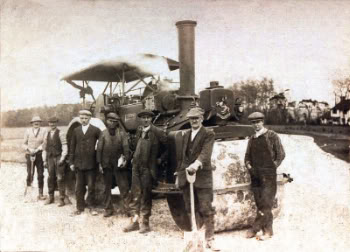The following announcement appeared in the Hobart Gazette of July 7, 1899:
WANTED: — Forty teams to work on gravel road in Ross township, beginning at Ainsworth; work to begin at once and I desire to give resident property owners this team work if they show the disposition to do the same. Price, $3.00 per day. Gahm & Byrne, contractors for said work.The graveling work on State Road 51 would extend from the northern border of Ross Township, just south of Hobart, down through Ainsworth and then west through Merrillville, eventually reaching Crown Point.
At those days there was a jog where State Road 51 crosses Deep River near the "Dorman place" (where the Indian Ridge Country Club is now). The bridge and the road north of it ran along the west line of Section 8, while south of the bridge the road ran along the east line of Section 7 — not much of a difference, but enough to annoy a number of Ross Township residents, who appealed to the County Commissioners to move the bridge and straighten the road. The Commissioners ultimately decided against doing that much work for the moment, choosing only to raise the existing bridge by two feet.
By mid-August, the Gazette reported concerns among the citizenry that the roads were not being graveled according to plan and that the contractors were using substandard materials, and unless things improved, an "indignation meeting" would be held. By early September, only a mile of road had been graveled.
If the "indignation meeting" ever took place, it wasn't reported. The graveling work went on slowly. In mid-November, the Gazette editorialized:
We had occasion to pass over the Ross township gravel roads the other day and as far as the work is completed we believe the tax payers of that township have little or no cause to complain. They must not expect a slag and gravel road to be as good as one built entirely of gravel.Early in January, a 142-acre farm south of Ainsworth sold for $50 an acre. The Gazette gave credit to the road improvements — before the graveling, the owners of that farm had been trying to sell it for some time and had gotten no better offer than $40 per acre.
In early November 1900 the work was finally completed. Now a person could drive the whole distance from Hobart to Crown Point on a gravel road.
A week later, a steam roller was brought in to smooth down the road better, but because of its weight and the softness of the road bed, it could be used only on the middle of the road. Horse rollers had to do the work on the sides of the road.

An early-twentieth-century road crew with steamroller.
Image credit: epsomandewellhistoryexplorer.org.uk.
In 1904 when Charles Maybaum, an Ainsworth-area farmer, was running for Ross Township Assessor, the Gazette mentioned the role he had played in the road improvements:
At present, Mr. Maybaum is road supervisor in his district and has filled the position with both credit to himself and the township for the past four years. To him is due great credit for the for the gravel road system that the township now possesses. After the project had failed at two previous elections Mr. Maybaum circulated a third petition and worked diligently in securing signers, which petition met with success at the polls.The graveling must have seemed a great improvement, especially in wet weather. But we've already seen that the gravel roads eventually deteriorated and proved inadequate as traffic increased and became motorized, and the Ross Township citizens of the late 1920s looked on gravel roads as the previous generation had looked on dirt roads.
Sources:
♦ "Additional Locals." Hobart Gazette 7 July 1899; 8 Sept. 1899.
♦ "General News Items." Hobart Gazette 5 Jan. 1900; 9 Nov. 1900; 16 Nov. 1900; 24 June 1904.
♦ "Local Drifts." 21 July 1899; 28 July 1899; 18 Aug. 1899; 17 Nov. 1899; 30 Nov. 1900.


No comments:
Post a Comment